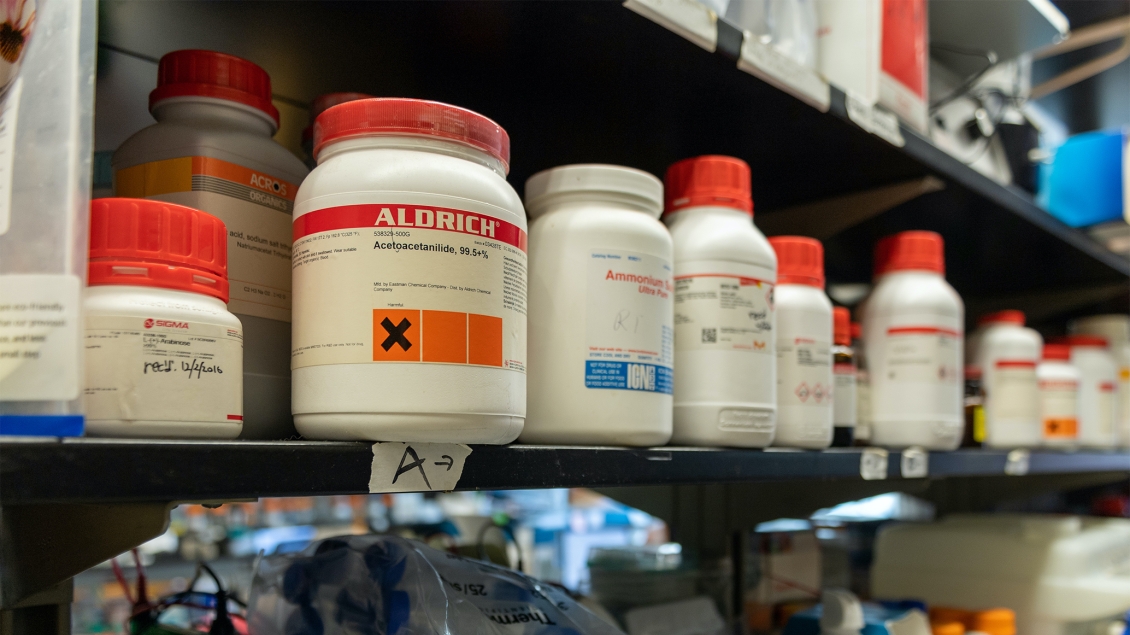
The Department of Biological Chemistry is at the center of a strong and diverse biochemical community at the University of Michigan. Please visit the profile pages and lab websites of our faculty members to explore our research interests and learn about opportunities for students, fellows and scientific collaborators.
Ryan Baldridge, PhD
Mechanisms of membrane-bound protein quality control systems
Ruma Banerjee, PhD
Chemical biology of hydrogen sulfide signaling; regulation of mammalian sulfur metabolism in health and disease; structural enzymology of human B12 trafficking proteins
Jay Brito Querido, PhD
Single-particle cryo-electron microscopy in combination with biochemical approaches to study how messenger RNA translation is regulated in human health and disease
Uhn-Soo Cho, PhD
Biochemical and structural studies of kinetochore assembly, histone chaperones, and Sestrin-mediated mTORC1 regulation
Michael Cianfrocco, PhD
Structural biology and biophysics underlying microtubule-based intracellular transport
Lydia Freddolino, PhD
Bacterial chromosomal structure and its effect on gene regulation; structure-function relationships in transcriptional regulators; merging experimental and computational data in protein-DNA and protein-RNA binding free energy landscapes; high throughput structure-based function prediction; optimal use of crosslinking mass spectrometry for structure determination; structural genomics
Tobias Giessen, PhD
Structure, function, and engineering of large protein assemblies
Daniel Goldman, PhD
Identification of signaling pathways, chromatin alterations, and gene expression programs that drive central nervous system regeneration using the retina as a model system
Phyllis Hanson, MD, PhD
Protein-protein and protein-membrane interactions involved in membrane trafficking and organelle structure
Tom Kerppola, PhD
Protein interactions and modifications in living cells and animals; roles of transcription factor complexes in the control of gene expression; mechanisms whereby cells and animals recognize and respond to synthetic chemicals
James Morrissey, PhD
Biochemistry of the human blood clotting system; structural studies of protein-membrane complexes
Rachel Niederer, PhD
Combining high-throughput experimental methods with biochemistry and molecular biology to discover translational control elements and characterize novel regulatory mechanisms impacting gene expression
Patrick O'Brien, PhD
Biochemical, biophysical, and structural approaches to understanding mechanisms of human DNA repair
Bruce Palfey, PhD
Enzyme reaction mechanisms and inhibitor design, with a focus on therapeutically important flavoproteins
Stephen Ragsdale, PhD
Molecular mechanisms and interactions of proteins involved in heme metabolism, the circadian clock, the global carbon cycle, and methylmercury; molecular mechanisms of redox, heme, and gas signaling pathways
Janet Smith, PhD
Structure-function studies of proteins using X-ray crystallography, with an emphasis on complex enzymes and the replication proteins of flaviviruses and alphaviruses
Raymond Trievel, PhD
Chemical and structural biology of enzymes that covalently modify histones, transcription factors, and other nuclear proteins; current research focuses on elucidating the molecular mechanisms underlying the specificities of histone methyltransferases and demethylases and on developing new assays and reagents to characterize them
David Turner, PhD
Transcriptional and post-transcriptional mechanisms that control neuronal differentiation; regulation of gene expression in the mammalian retina by microRNAs and other small RNAs
Michael Uhler, PhD
Neuronal signaling and gene expression in the context of human neurologic and psychiatric disorders
Anne Vojtek, PhD
Molecular and biochemical analysis of signaling pathways that regulate cell proliferation and neural differentiation
Chase Weidmann, PhD
Integrating multi-omics technologies and cell-based functional assays to characterize ribonucleoprotein networks in biology and human disease
Zhaohui Xu, PhD
Structural biology and molecular mechanisms of protein folding and trafficking in eukaryotic cells
Yan Zhang, PhD
Biology, mechanisms, and technological applications of bacterial CRISPR-Cas systems
James Bardwell, PhD
Roles of molecular chaperones and disulfide catalysts in protein folding; experimental evolution of protein folding
Wei Cheng, PhD
Using biochemical approaches aided by biophysical tools to mechanistically dissect the responses of B cells to particulate antigens both in vivo and in vitro, with a focus on the quantitative features of viral particles and their impact on B cells
Renny Franceschi, PhD
Signals regulating the formation and functioning of osteoblasts, the cells that produce and mineralize the extracellular matrix of bone; control of gene expression in osteoblasts
Ursula Jakob, PhD
Biochemical aspects of the bacterial response to oxidative stress
Neil Marsh, PhD
Structure and mechanism of radical S-adenosylmethionine-dependent enzymes, enzymes in hydrocarbon biosynthesis and degradation, design of self-assembling protein nano-cages
Shyamal Mosalaganti, PhD
Applying cryo-electron tomography and other biochemical and cell biological methods to understand how lysosomes perform their functions, undergo repair, and communicate with other organelles to maintain cellular fitness
John Prensner, MD, PhD
RNA translation in the non-coding genome; multi-omics approaches to elucidate patterns of translational regulation (or dysregulation) in pediatric cancer
Brian Ross, PhD
Molecular imaging of biological processes in living tissue, including noninvasive detection of molecular signaling events to investigate cancer growth and response to therapy
Debra Thompson, PhD
Molecular studies of the function of the mammalian retina, including mechanisms that control signal transduction and tissue-specific gene expression in the retinal pigment epithelium
Nils Walter, PhD
Powerful single molecule studies of mechanistic structure-dynamics-function relationships in RNAs of biomedical and bioanalytical significance; current work ranges from small bacterial riboswitches to RNA-protein complexes involved in human disease